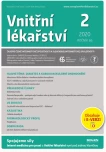Relation between testosterone levels and body composition, physical functioning and selected biochemical parameters in adult males
Autoři:
Milan Sedliak 1; Michal Kralik 1; Jan Cvecka 1; Gabriel Buzgo 1; Matus Putala 1; Barbara Ukropcová 2,7; Jozef; Ukropec 2; Zdenko Kilinger 3; Juraj Payer 3; Boris Kollárik 4; Peter Bujdak 5; Truls Raastad 6
Vyšlo v časopise:
Vnitř Lék 2020; 66(2): 71-76
Kategorie:
Původní práce
Souhrn
Introduction: The objective of the study was to examine the relationship between the values of selected parameters of physical function, body composition, body mass index (BMI) and biochemical markers of metabolic health with the total testosterone (TT) levels in adult males. We aimed to analyse the correlation between these values and variations in the TT levels.
Methods: A total of 17 subjects (age = 50.2 ± 8.1 years, TT = 11.4 ± 3.8nmol/l) were included in the study. Subjects were tested on physical function (1RM on leg press, bench-press, handgrip, VO2max), body composition (DXA), biochemical parameters (morning fasting blood samples).
Results: TT was inversely correlated with abdominal circumference (AC) (p <0.01) and with overall body fat, measured in kg (p <0.01). On a biochemical level, significant correlations were found between TT and insulin (p <0.01), and TT and homeostasis model assessment of insulin resistance (HOMA-IR) (p <0.01). Physical function, muscle strength or lean mass were not significantly correlated with TT.
Conclusion: The main finding of this study was that testosterone levels had a strong inverse correlation with abdominal circumference and total body fat mass. On metabolic level, strong inverse correlation was also found between TT with insulin and TT with HOMA-IR. However, we did not find statistically significant correlation between total testosterone levels and lean mass, muscle strength or physical function in middle aged males.
Klíčová slova:
kompozice těla – testosterón – obezita
Zdroje
1. Bhasin S, et al. Testosterone therapy in adult men with androgen deficiency syndromes: an endocrine society clinical practice guideline. J Clin Endocrinol Metab 2006; 91 : 1995–2010.
2. Bianchi VE, Locatelli V. Testosterone a key factor in gender related metabolic syndrome. Obes Rev 2018; 19 : 557–575.
3. Hsu B, Cumming RG, Handelsman DJ. Testosterone, frailty and physical function in older men. Expert Rev Endocrinol Metab 2018; 13 : 159–165.
4. Borst SE, Mulligan T. Testosterone replacement therapy for older men. Clinical Interventions in Aging 2007; 2 : 561–566.
5. Wang C, et al. REVIEW ISA, ISSAM, EAU, EAA and ASA recommendations: Investigation, treatment and monitoring of late-onset hypogonadism in males. International Journal of Impotence Research 2009; 21 : 1–8.
6. Jaworski PED, Ramos A, Nicoleit AR, et al. Importance of abdominal circumference and body mass index values in predicting male hypogonadism; A practical approach. Archives of Endocrinology and Metabolism 2017; 61 : 76–80.
7. Corona G, Bianchini S, Sforza A, et al. Hypogonadism as a possible link between metabolic diseases and erectile dysfunction in aging men. Hormones (Athens) 2015; 14 : 569–578.
8. Santosa S, Jensen MD Effects of male hypogonadism on regional adipose tissue fatty acid storage and lipogenic proteins. PLoS One 2012; 7: e31473.
9. Kelly DM, Jones TH. Testosterone and obesity. Obes Rev 2015; 16 : 581–606.
10. Reynolds JM Prediction of one repetition maximum strength from multiple repetition maximum testing and anthropometry. Journal of Strength and Conditioning Research 2006; 20 : 584–592.
11. Ebbeling CB, Ward A, Puleo EM, et al. Development of a single-stage submaximal treadmill walking test. Med Sci Sports Exerc 1991; 23 : 966–973.
12. Akishita M, Fukai S, Hashimoto M, et al. Association of low testosterone with metabolic syndrome and its components in middle aged Japanese men. Hypertension Res 2010; 33 : 587–591.
13. Grossmann M et al. Low Testosterone Levels Are Common and Associated with Insulin Resistance in Men with Diabetes. The Journal of Clinical Endocrinology & Metabolism 2008; 93 : 1834–1840.
14. Dandona P, Rosenberg MT. A practical guide to male hypogonadism in the primary care setting. International Journal of Clinical Practice 2010; 64 : 682–696.
15. Shamim MO, Khan FMA, Arshad R. Association between serum total testosterone and Body Mass Index in middle aged healthy men. Pak J Med Sci 2015; 31 : 355–359.
16. Huhtaniemi I Late-onset hypogonadism: Current concepts and controversies of pathogenesis, diagnosis and treatment. Asian J Androl 2014; 16 : 192–202.
17. Hildreth KL, Barry DW, Moreau KL, et al. Effects of testosterone and progressive resistance exercise in healthy, highly functioning older men with low-normal testosterone levels. The Journal of Clinical Endocrinology and Metabolism 2013; 98 : 1891–1900.
Štítky
Diabetologie Endokrinologie Interní lékařstvíČlánek vyšel v časopise
Vnitřní lékařství

2020 Číslo 2
- Není statin jako statin aneb praktický přehled rozdílů jednotlivých molekul
- Dávkování a správná titrace dávky pregabalinu
- Biomarker NT-proBNP má v praxi široké využití. Usnadněte si jeho vyšetření POCT analyzátorem Afias 1
- Osteoporóza v praxi: Kdy léčit v primární péči a kdy referovat do osteocentra?
Nejčtenější v tomto čísle
- Diferenciální diagnostika hypoglykemie
- Hypoxemie/hypoxie a nové koncepty oxygenoterapie v intenzivní péči
- Thymom – možnosti diagnostiky
- Diosmin/hesperidin – spolupracující tandem nebo je diosmin klíčový a hesperidin jen neúčinnou příměsí?
